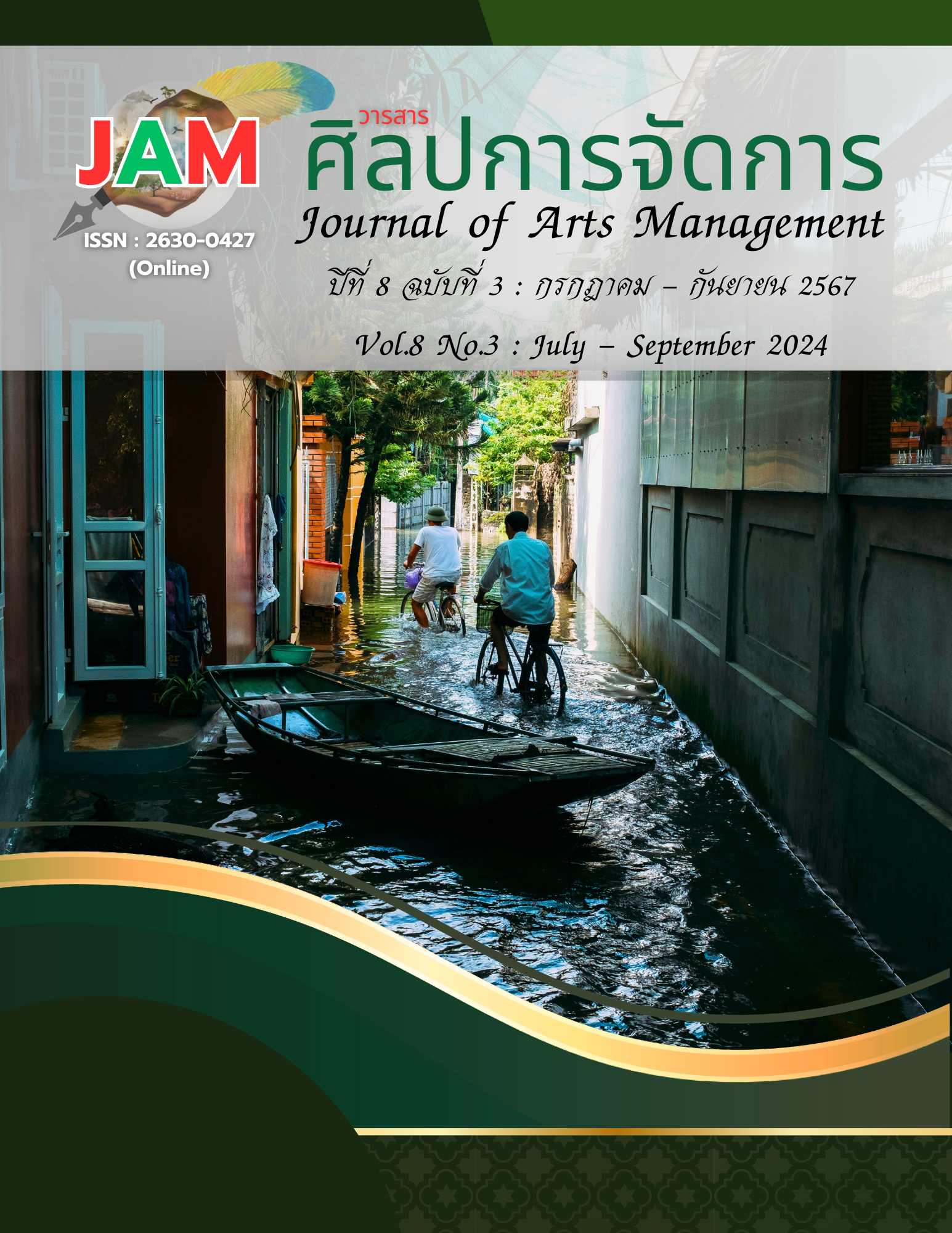Factors Affecting the Use of Facial Recognition Technology for Payment Transactions of Bangkok Consumers
Main Article Content
Abstract
This article aimed to study the factors affecting the use of facial recognition technology for payment transactions by Bangkok consumers. The study used a quantitative approach and a survey method to collect data from 385 respondents in Bangkok who were at least 15 years old. Using a random sampling method to determine the sampling pattern is accidental selection because the exact population is unknown. Data were collected using a questionnaire. Descriptive statistics were used to characterize the sample's baseline characteristics, and multivariate analysis applying linear regression was employed to determine the variables influencing the adoption of facial recognition technology for consumer payment transactions. The study found that security, usage intention, social image, and perceived usefulness positively influence consumers' intention to use facial recognition technology for payment transactions, with statistical significance at the 0.05 level. These factors can together explain up to 85.5% of the use of facial recognition technology for payment transactions. Therefore, the development of technology to be compatible with consumer needs must consider these factors together. In addition, relevant agencies should educate the public about facial recognition technology to create understanding and reduce concerns about using this technology.
Article Details

This work is licensed under a Creative Commons Attribution-NonCommercial-NoDerivatives 4.0 International License.
Views and opinions appearing in articles in the Journal of Arts of Management It is the responsibility of the author of the article. and does not constitute the view and responsibility of the editorial team I agree that the article is copyright of the Arts and Management Journal.
References
Bentham, J. (2000). An Introduction to the Principles of Morals and Legislation. Batoche Books.
Chang, C., & Hwang, G. (2019). Trends in Digital Game-Based Learning in the Mobile Era: A Systematic Review of Journal Publications from 2007 to 2016. International Journal of Mobile Learning and Organization, 13(1), 68-90.
Chaweesuk, S., & Wongjaturaphat, S. (2012). Theory of acceptance of information technology. KMITL Information Technology Journal, 1(1), 1-21.
Cheng, X., Qiao, L., Yang, B., & Zhang, X. (2022). Investigation on users’ resistance intention to facial recognition payment: a perspective of privacy. Electronic Commerce Research. https://doi.org/10.1007/s10660-022-09588-y
Cochran, W. G. (1954). The combination of estimates from different experiments. Biometrics, 10(1), 101-129.
Dabkaew, C., & Jarintho, K. (2018). Success and satisfaction in Mobile Banking among Thai, Singaporean and Malaysian banks. Humanities and Social Sciences Research Promotion Network Journal, 1(3), 25-37.
Davis, F. (1985). A technology acceptance model for empirically testing new end-user information systems: theory and results[Doctoral Dissertation, MIT Sloan School of Management Cambridge MA.].
Jaradat, M.R.M., & Faqih, K.M.S. (2014). Investigating the moderating effects of gender and self-efficacy in the context of mobile payment adoption: a developing country perspective. International Journal of Business and Management, 9(11), 147-169.
Leelathanakiri, C., & Suwanna, T. (2018). Factors Affecting the Acceptance of Banking Transaction
on Smartphones in Bangkok and Vicinity. EAU Heritage Journal Social Sciences and Humanities Edition, 8(3), 100-111.
Leepipatpaiboon, P., & Lertmethapat, N. (2019). Artificial intelligence in Thailand: Case study in financial services. Bank of Thailand.
Li, C., & Li, H. (2023). Disentangling facial recognition payment service usage behavior: A trust perspective. Telematics and Informatics, 7, 1-15. https://doi.org/10.1016/j.tele.2023.101939
Luaddinan, K. (2014). Technology acceptance and online consumer behavior affecting e-books' purchase decisions of customers in Bangkok[Master’s thesis, Bangkok University].
Kaewmane, K. (2020). Factors affecting customers use Pao Tang Application on M.33 Rao Rak Kan. Journal of Academic for Public and Private Management, 2(3), 134-142.
Ketikidis, P. (2011). Acceptance of health information technology in health professionals: An application of the revised technology acceptance model. Proceedings of the 15th International Symposium on Health Information Management Research – ISHIMR 2011.
Nan, D., Kim, Y., Huang, J., & Sun Jung, H. (2022). Factors affecting intention of consumers in using face recognition payment in offline markets: an acceptance model for future payment service. Frontiers in Psychology, 13, 1-11. DOI: 10.3389/fpsyg.2022.830152
Saengprasert, N., Sasithanakornkaew, S., & Apisupachoke, W. (2022). Factors influencing acceptance and behavior to use of Paotang Application. Mahachula Nakornrat Journal, 9(4), 245-259.
Sombat, P. (2021). Factors influencing the intention to use the service innovation of “Mor Prom” Application in Bangkok. Journal of Accountancy and Management Mahasarakham University, 14(1), 142-160.
Sukamart, M. (2019). The criminal liability of artificial intelligence. Ubon Ratchathani Rajabhat Law Journal, 7(2), 37-49.
Prasitratsin, S. (2007). Research and methodology in social science. Samlada.
Robinson, C., & Barlow, W. (1959). Image public relations. Public Relations Journal, 15, 10-13.
Schepers, J., & Wetzels, M. (2007). A meta-analysis of the technology acceptance model: Investigating subjective norm and moderation effects. Information & Management, 44(1), 90–103.
Stevens, W. (1996). Letters of wallace stevens. University of California Press.
Thongmala, P. (2015). The users Electronic Government Procurement (e-GP) of Rajmangala University of Technology[Master’s thesis, Prince of Songkla University].
Vanichbancha, K. (2006). Statistics for research. Sam Lod Limited Partnership.
Vroom, H. V. (1964). Work and motivation. Wiley and Sons.
Udomthanawong, S. (2019). Brand image and technology acceptance affecting hotel booking intention via applications. Kasem Bundit Journal, 20(2), 56-67.
Wongyara, W. (2020). Factors affecting actual usage of e-wallet through Super Apps: Case study Rabbit Line Pay and Grab Pay. Journal of Information Systems in Business (JISB), 6(3), 11-28.
Wu, B., & Chen, X. (2017). Continuance intention to use MOOCs: Integrating the technology acceptance model (TAM) and task technology fit (TTF) model. Computers in Human Behavior, 67, 221-232.
Zhang, W., & Kang, M. (2019). Factors affecting the use of facial-recognition payment: An example of Chinese consumers. IEEE Access, 9, 154360-74.


